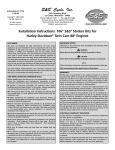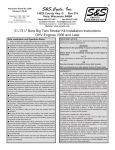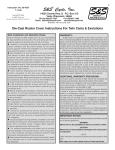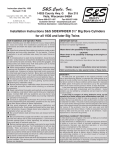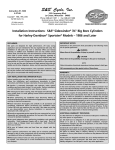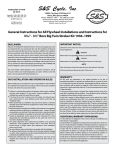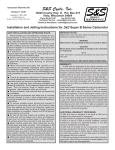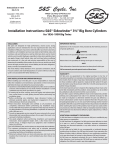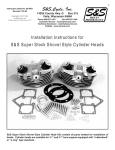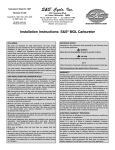Download Evo Engine - Nightrider.com
Transcript
1 Instruction sheet No.00-3101 Revised 6-29-99 Copyright ©, 1997 by S&S Cycle, Inc. All rights reserved. Printed in the U.S.A. S&S Cycle, Inc. 14025 County Hwy. G P.O. Box 215 Viola, Wisconsin 54664 Phone: 608-627-1497 Fax: 608-627-1488 Customer Service - sscust@sscycle.com Technical Assistance - sstech@sscycle.com Installation Instructions for S&S Big Twin Style Long Block Assembly Safe Installation and Operation Rules: Important Notice: ● Before finishing and installing your S&S Long Block, it is your responsibility to read and follow the installation and maintenance procedures in these instructions and to follow the basic rules below for your personal safety. ● Gasoline is extremely flammable and explosive under certain conditions, and the fumes toxic when inhaled. Do not smoke around gasoline. Perform the installation in a well-ventilated area away from open flames or sparks. ● Compressed air and particles dislodged by compressed air are harmful to eyes and body. Wear protective goggles when using compressed air and always direct the air stream away from your eyes and body and other people nearby. ● Some solvents, degreasers and other chemicals are harmful, especially to skin and eyes. Many chemical compounds such as lacquer thinner are also flammable and present a fire hazard. Read the manufacturer’s instruction label for precautions and proper use. Use in a well ventilated area and wear protective clothing to avoid personal injury. ● If the motorcycle has been running, wait until the engine and exhaust pipes have cooled before performing any installation steps to avoid getting burned. ● Before performing any installation steps, disconnect and remove the battery to eliminate potential sparks and inadvertent engagement of the starter while working on the motorcycle. ● Read instructions thoroughly and carefully so all procedures are completely understood before performing any installation steps. Contact S&S if you have questions, if any steps are unclear, or if any abnormalities occur during final assembly, installation, or operation. ● Contact an authorized H-D service manual for correct disassembly, reassembly, and installation procedures for any parts that need to be removed to facilitate the installation. ● Use good judgment during assembly, installation, and when operating the motorcycle. Good judgment begins with a clear head. Don’t let alcohol, drugs, or fatigue impair judgment. Perform the assembly and installation when fresh. ● For optimum performance and safety and to minimize potential damage to the Long Block or other components, use correct hardware and follow procedures outlined in S&S instructions and an authorized H-D service manual. ● Be sure all oil and fuel lines are routed correctly with clamps in place and tightened. Lines must not contact exhaust pipes or other hot surfaces where they could melt or leak and catch fire. ● Motorcycle exhaust fumes are toxic and must not be inhaled. Run motorcycle only in a well ventilated area where fumes can dissipate. ● S&S Long Blocks are substantially more powerful than the stock engines they often replace. It is the sole and exclusive responsibility of the user to determine the suitability of the product for his or her use. The user shall assume all legal, personal injury risk and liability and all other obligations, duties and risks associated therewith. S&S parts are intended for experienced riders only. Statements in this instruction sheet preceded by the following words are of special significance: WARNING Means there is the possibility of injury to yourself or others. CAUTION Means there is the possibility of damage to the motorcycle or a component. NOTE Other information of particular importance has been placed in italic type. S&S urges you to take special notice of these advisories. Warranty: All S&S parts are guaranteed to the original purchaser to be free of manufacturing defects in materials and workmanship for a period of six (6) months from the date of purchase. Merchandise that fails to conform to these conditions will be repaired or replaced at S&S’s option if the parts are returned to S&S by the purchaser within the 6 month warranty period or within 10 days thereafter. In the event warranty service is required, the original purchaser must notify S&S of the problem immediately. Some problems can be rectified by a telephone call and need no further action. A part that is suspected of being defective must not be replaced without prior authorization from S&S. If it is deemed necessary for S&S to make an evaluation to determine whether the part was defective, it must be packaged properly to avoid further damage, and be returned prepaid to S&S with a copy of the original invoice of purchase and a detailed letter outlining the nature of the problem, how the part was used, and the circumstances at the time of failure. If after an evaluation was made by S&S and the part was found to be defective, repair, replacement, or refund will be granted. Additional Warranty Provisions: (1) No part shall be returned to S&S without first contacting the company and obtaining a Return Authorization (RA) number. (2) S&S shall have no obligation in the event an S&S part is modified by any other person or organization, or if another manufacturer’s part is substituted for one provided by S&S. (3) S&S shall have no obligation if an S&S part becomes defective in whole or in part as a result of improper installation, improper break-in or maintenance, improper use, abnormal operation, or any other misuse or mistreatment. (4) S&S shall not be liable for any consequential or incidental damages resulting from the failure of an S&S part, the breech of any warranties, the failure to deliver, delay in delivery, delivery in non-conforming condition, or for any other breach of contract or duty between S&S and a customer. (5) S&S parts are designed exclusively for use on Harley-Davidson motorcycles. S&S shall have no warranty or liability obligation if an S&S part is used in any other application. PRESENT S&S CRANKCASES AND FLYWHEELS ARE NOT COMPATIBLE WITH HARLEY-DAVIDSON ELECTRONIC FUEL INJECTION (EFI) MODELS. 2 INTRODUCTION S&S V2 and Shovel Style Long Blocks are available in several stages of completion. Final assembly depends upon which version was purchased. Long Block Instructions often refer to procedures described in other S&S instructions or a Harley-Davidson Service Manual. These materials should be cross-referenced as necessary. Because of the large number of instructions provided with each Long Block, it is recommended that they be arranged in sequence according to Instruction Sheet # printed in top left corner. In most instances, assembly of S&S V2 and Shovel Style Long Blocks is similar. Exceptions will be noted where applicable. All Long Blocks are designed for frames that accept HarleyDavidson Big Twin engines. Most fit stock H-D and similar frames without modification. Some Long Blocks are significantly taller than stock as a result of increased stroke, and may require frame modifications. While this applies mostly to 96, 98 and 103 cubic inch Shovel Style, and 103 in. V2 Style Long Blocks, S&S strongly recommends trial-fitting every engine before frame is painted or powder coated. Because the Special Application crankcase is 1⁄4 inch wider than stock, fit of exhaust, rear brake master cylinder, and foot controls must be closely checked when installing 4 inch bore or other Long Block with SA crankcases. Some components may require modification. Picture 1 responsibilities of the customer. If not thoroughly familiar with these procedures, he should contact a professional mechanic. General tuning guidelines appear on Long Block Instructions, pages 13, and Carburetor Instruction Sheet #0400, pages 12 & 13. WARNING - In some instances, brake master cylinder must be spaced out from frame to clear SA crankcase. UNDER NO CIRACUSTANCES SHOULD MASTER CYLINDER OR BRAKE LINE BE ALLOWED TO CONTACT EXHAUST PIPE IN FINAL INSTALLATION. Heat trasferred to brake fluid may expand and cause brakes to seize, resulting in possible fire hazard and loss of control of motorcycle with injury or death to rider and others. CAUTION - Incorrect ignition or carburetor tuning can cause extensive engine damage not covered under warranty. ● Powder coating and polishing - While S&S does manufacture some powdercoated Long Blocks, it does not recommend having engine parts powdercoated or otherwise modified elsewhere. Many such procedures leave abrasive residues which are difficult to remove completely. Also, powder coating is cured at high temperatures that can change the strength characteristics of some metals. IMPORTANT NOTES ● Lubrication - S&S supplies Torco Engine Assembly Lube with each Long Block. It should be used as specified in following instructions. While other brands of assembly lube are acceptable, other lubricants are not. In no instance should an aerosol lubricant be substituted for assembly lube. ● Engine tuning - Ignition timing and carburetor jetting are CAUTION - Glass bead and polishing residues are abrasive and can be difficult to remove from recesses and small passages. Abrasive residues can cause oil contamination and extensive engine damage. Engine damage caused by powder coating, polishing, glass bead blasting, or other modification will not be covered under warranty. Picture 2 Picture 3 3 Picture 4 ASSEMBLY NOTE - While S&S has made every effort to insure that parts are correct, it is the engine builder’s responsibility to confirm fit and finish of all parts provided with Long Blocks prior to assembly. Parts are deburred at S&S and usually require no further preparation, but must also be inspected by installer. Individual parts should not be removed from protective plastic wrappers until needed. After removal from plastic, it is imperative that parts be thoroughly cleaned and dried, preferably with compressed air. When present, rust preventative must be completely removed. Additionally, gaskets must be closely inspected for particles that could become dislodged and damage engine. If assembly of Long Block must be interrupted, seal openings and cover engine with plastic to protect from destructive contaminants. CAUTION - Failure to observe the above may result in engine damage not covered under warranty. FLYWHEELS (All Unassembled Long Blocks) Carefully read S&S Big Twin Pinion Shaft Installations #2027, S&S Connecting Rod Instructions #2300 and Installation Instructions for S&S Super Stock and Special Application Big Twin Crankcases #31-0000M before proceeding. 1. Confirm that correct brass plug has been installed in end of pinion shaft. Plug for side oiling engines (pre-1973) will be solid. Plug for 1973-up end oiling engines will have 3⁄32” hole. 2. Confirm pinion shaft main bearing fit. Bearing supplied should be correct size, but must be verified by engine builder according to procedure in S&S Crankcase Instructions, page 9. Flywheel assembly can then be prepared for installation as described in Special Instructions for Fully Assembled S&S Flywheel Sets, #2001. Picture 5 INSTALL FLYWHEELS IN CRANKCASE (All Unassembled Long Blocks) 1. Thoroughly clean parts according to instructions previously mentioned. Apply coat of assembly lube to bearing surface of sprocket shaft and inner race of Timken bearing. Install bearing on shaft with appropriate tool. See Picture 1. NOTE - S&S does not recommend using a press to install sprocket shaft bearings, as this can push flywheels out of true. Correct bearing installation tools are available from Harley-Davidson, Jim’s Machine, and other sources. 2. Apply coat of petroleum jelly to Timken bearing installed in Step 1. See Picture 2. 3. Place left side crankcase half on sprocket shaft and bearing, insuring that connecting rods are in correct positions. See Picture 3. 4. Install Timken bearing spacer. See Picture 4. 5. Lubricate rollers of remaining Timken bearing with petroleum jelly. Apply assembly lube to bearing inner race and sprocket shaft bearing surface. Install bearing on shaft with appropriate tool. See Picture 5. CRANKCASES (All Unassembled Long Blocks) Refer to S&S Crankcase Instructions #31-0000M for information on preparing crankcases. Additionally, blow out cam bearing and all oil passages with compressed air. Picture 6 4 Picture 8 (V2 Style) Picture 7 6. Lubricate pinion bearing and pinion shaft bearing boss with petroleum jelly. Install bearing and secure with pinion shaft main bearing snap ring. See Picture 6 on previous page. NOTE - Pinion and sprocket shaft bearings should be correct sizes, but it is engine builder’s responsibility to confirm flywheel endplay, connecting rod sideplay, bearing fit, and all clearances in Unassembled Long Block at time of assembly. It is of particular importance to check flywheel endplay and install different Timken bearing spacer if necessary. Refer to Harley-Davidson Service Manual for detailed explanation of required procedure. NOTE - Harley-Davidson has used different style pinion bearings in various models, some requiring different snap rings. Snap ring supplied by S&S or identical replacement must be used with pinion bearing supplied in S&S Long Block. NOTE - Ends of snap ring are rounded on one side, sharp on the other. Install snap ring with sharp edge out, away from flywheels. A B H C D G E F Diagram1 ASSEMBLE CRANKCASE HALVES 1. Noting solvent precautions on page 1, wipe down mating gasket surfaces of crankcase halves with lacquer thinner. Remove residue with clean, dry cloth, then apply sealant of choice to pinion side crankcase. Take care to avoid breather cavity and other areas where sealant might reach inside of engine. See Picture 7. Coat right main bearing race with petroleum jelly. If applicable, allow sealant to cure according to manufacturer’s instructions, then join left and right crankcase halves. NOTE - In most instances S&S uses Hylomar or Threebond 1104 to seal crankcase. Use any sealant carefully to prevent excess from entering engine and obstructing oil passages or contaminating oil supply. 2. Install crankcase studs and washers according to crankcase instructions. NOTE - Alignment studs for S&S generator and alternator crankcases are in locations B, E, & G. See Diagram 1. They must be installed before other studs and bolts. Fit is tight, so alignment studs must be lubricated with assembly lube, then tapped through case assembly with plastic mallet. 3. Tighten 5⁄16” case bolts and studs to 15-18 ft-lbs, 1⁄4” center bolt to 10-12 ft-lbs. See Diagram 1 for identification, and tighten fasteners in following sequence: G-B-E-FH-D-C-A. 4. Install drive sprocket spacer and sprocket shaft oil seal in main bearing race of left case. NOTE - Because of semi-dry primary housing in Shovelheads and sealed, wet primary in V2’s, S&S installs Shovelhead sprocket shaft seals with spring facing inside, V2 seals with spring out. See Picture 8. 5. Allow crankcase sealant to cure per mfr.’s instructions, then pour four ounces of motor oil over bearing end of connecting rod assembly and into flywheel cavity. Rotate flywheels several times to distribute oil over connecting rod bearings. Assembly should turn freely and without binding. 5 Picture 9 Picture 10 (Pump shown is optional billet oil pump) INSTALL OIL PUMP (All Unassembled) 1. Disassemble, clean and inspect oil pump, leaving supply drive gear, key, and snap ring in place on shaft. Refer to S&S Oil Pump Installation Instructions #6250 and Service Bulletin 15. NOTE - In some instances, oil pump gears have marks. To assure proper gear mesh, marks must align when gears installed in pump body. See Picture 9. (Marks in photo have been darkened. They normally appear as light punch marks.) CAUTION - Failure to align marks may result in gear bind and possible damage to oil pump or other engine parts. 2. Reassemble pump, applying assembly lube to gears and gear cavities in pump body. Remove excess to avoid contaminating gaskets. Rotate gears as preliminary check for bind, and to confirm that drive gear keys properly installed. NOTE - Many S&S oil pumps offer more than one location for oil supply fitting. Lowest fitting should not be used on Dynas, late FL’s, or other models with oil tank below transmission. S&S recommends stock placement for oil supply fitting in Dynas and late FL’s. See Picture 10. CAUTION - Routing oil supply line to lowest fitting on models with oil tank below transmission could allow air to enter oil pump under certain circumstances, causing “air lock,” loss of lubrication and engine damage. 3. Apply assembly lube to oil pump driveshaft and driveshaft bushing in crankcase. See Picture 11. Install oil pump in normal fashion, placing pump drive gear #33-4230 over driveshaft as shaft is passed through crankcase bushing. Refer to S&S Oil Pump Instructions and Harley-Davidson Service Manual as needed. NOTE - If bind occurs, determine whether problem is with supply or return gears by removing idler gear from either side and rotating pump. When binding gear is removed, pump will rotate freely. Problem can usually be corrected by rotating gear 180°. NOTE - A dab of Hylomar or other thin gasket sealer in corners may be used to hold gaskets in place. Otherwise gaskets should be installed dry. Picture 11 Picture 12A 6 Picture 12B (Correct Installation) 4. Install driveshaft gear key and snap ring. NOTE - Be sure drive shaft key and snap ring are installed properly, paying particular attention to snap ring. If not installed correctly, “sprung,” or otherwise damaged, snap ring may come off or allow gear key to come out. See Pictures 12A & B. CAUTION - Loss of oil pump drive gear snap ring or key will result in disengagement of oil pump causing loss of oil pressure and extensive engine damage. 5. Loosely install 2 ea. 1⁄4 -20 x 11⁄2” top oil pump bolts, followed by pump cover and 4 ea. 1⁄4 -20 x 2 3⁄4” mounting bolts. Do not tighten at this time. NOTE - 1⁄4 -24 bolts supplied with oil pump kit are not used in S&S Long Block. 6. While turning oil pump drive gear to check pump for binding, gradually tighten 4 - 2 3⁄4” bolts in X-pattern to final spec. of 8-10 ft-lbs. See Picture 13. Carefully tighten short bolts “by feel” with thin box end wrench. Picture 14 (Note chamfer) Picture 13 7. Prime pump by removing oil pump check valve ball assembly (See illustration on page 15 in Oil Pump Instructions) and injecting clean motor oil into pump supply fitting while turning oil pump drive gear. (A large plastic squeeze bottle works well for priming pump.) Replace check ball, spring, and cap after oil fills check valve cavity. INSTALL PINION GEAR, SPACER & NUT (All Unassembled) 1. With chamfer on oil pump drive gear facing in towards shoulder on pinion shaft (See Picture 14), install oil pump drive gear and key on pinion shaft, followed by drive gear spacer. CAUTION - Installing gear backwards can result in a stress riser and cause shaft to break. 2. Apply thin film of red Loctite #271 to pinion shaft taper and threads. Install pinion gear, key and nut on pinion shaft and tighten nut to 50 ft-lbs. See Picture 15. S&S Picture 15 7 Picture 16A Connecting Rod Checking Pin, part #53-0002, can be used to prevent flywheels from turning as pinion nut tightened on shaft. NOTE - Drive gear spacer will not completely fill space between oil pump drive gear and pinion gear. A gap of up to .125” may exist and is normal. Engine rotation keeps oil pump gear in place during normal operation. Spacer prevents gear and key from becoming disengaged if engine rotated backwards. CAUTION - Installing pinion gear or nut without Loctite can cause damage to shaft, nut, or other parts. 3. In Generator Style Long Blocks only, install intermediate and circuit breaker drive gears, and spacers if applicable. NOTE - To increase bushing surface area, S&S intermediate and circuit breaker drive gears do not utilize spacers. Correct end play of .003-.007 in. must be established using shims provided with gears. Picture 17 Picture 16B Timing mark on circuit breaker drive gear must align with mark on pinion gear. Other mark on pinion gear must be positioned to align with mark on camshaft gear when camshaft installed. See Picture 16A. INSTALL BREATHER GEAR, CAMSHAFT, AND GEAR COVER (All Unassembled) 1. Thoroughly clean and dry all parts including camshaft lockwasher and thrust washer. Carefully inspect breather gear for burrs and remove as necessary. Inspect edges of crankshaft breather “window” for burrs and smoothness. Cam thrust washer and breather gear shims should be correct size, but endplay of camshaft and breather gear must be verified by customer. Refer to S&S Camshaft Instruction Sheet #2340, Gear Cover Instructions No. 3102, and Harley-Davidson Service Manual as necessary. 2. Apply light coat of Vaseline to cam bearing, and coat of assembly lube to cam lobes, camshaft lockwasher, thrustwasher, breather gear, and to breather gear cavity inside engine. 3. Place camshaft lockwasher in case with ears down and flat edge towards rear of engine. See Picture 17. 4. Install thrust washer over end of cam and place assembly in engine. During installation, rotate engine so marks on cam gear and pinion gear align. Second mark on cam gear must be at eight o’clock position. In Generator Style Long Blocks, second mark on pinion gear must be at two o’clock position to align with mark on circuit breaker drive gear. 5. Install breather gear and shim, aligning breather gear timing mark with mark at eight o’clock on cam gear. See Picture 16B. 6. In Generator Style Long Blocks only, install breather screen and separator (not supplied by S&S) if desired. 7. Use connecting rods to rotate flywheels and insure gears rotate freely. Apply assembly lube to ends of shafts and meshing surfaces of gears and remove excess. 8. Apply assembly lube to gear cover bushings. 9. Clean gasket surfaces on engine and gear cover with lacquer thinner, wipe dry, and apply light film of Hylomar or preferred sealant to both sides of gasket. 8 Picture 18 Picture 19 10. Install gasket and cover and tighten screws to 10-12 ft-lbs. 4. Thoroughly clean and dry gasket surfaces of lifter guides and crankcase. Place rear gasket on crankcase, assuring that oil hole in gasket aligns with passage in case. 5. Taking care not to dislodge or contaminate gasket, lower rear guide assembly into place. Fingers can be inserted through front lifter guide opening to support lifters. 6. Insert Harley-Davidson alignment tool HD #HD-33443 or similar tool from other source in lifter guide screw hole by oil passage. See Picture 19. Install and tighten guide screws in three remaining holes. Remove tool, install fourth screw, and tighten all to 10-12 ft-lbs. 7. Repeat procedure for front lifter-guide assembly. Assembly lube will usually hold lifters in guide during installation. If resistance encountered during installation, check to see if lifter has become dislodged. 8. Apply thread sealant to threads of oil pressure switch and install. NOTE - Gear cover should slide smoothly over alignment dowels and must not be forced. Confirm that gasket material does not overlap oil passages in crankcase and gear cover. See Picture 18 . CAUTION - Having to force gear cover indicates alignment problem. Problem must be identified and corrected before operating engine. Operating engine with forced gear cover could result in broken pinion shaft or other engine damage. 10. Rotate flywheels to check for binding. If present, cause of bind must be determined and corrected. If assembly rotates freely, pour approximately four ounces of oil into gear compartment after allowing crankcase sealant to cure per manufacturer’s instructions. Install Shovelhead lifters and guides according to manufacturer’s instructions. INSTALL LIFTERS AND LIFTER GUIDES (All Unassembled) NOTE - S&S installs HL2T (Hydraulic Lifter Limited Travel) Kit in lifters in Assembled V2 Style Long Blocks. HL2T Kit is included with Unassembled V2 Style Long Blocks, but not installed. S&S recommends using kit. However, some customers feel adjustment procedure is excessively timeconsuming and prefer to omit kit. If desired, install kit according to Installation Instructions for S&S Hydraulic Lifter Limited Travel Kit #5038 before proceeding. Install V2 Style lifters and guides as follows: 1. Remove oil pressure sending unit behind rear lifter guide opening. 2. Identify gaskets for front and rear lifter guides and apply thin film of Hylomar or preferred sealant to both sides of each. Gaskets are not interchangeable. 3. Coat lifter guide bores with assembly lube and insert lifters. Work lifters back and forth in guides, assuring that they move freely and without binding. Apply assembly lube to lifter rollers and remove any excess. '92-Earlier '93-Later Picture 20 9 '92-Earlier '93-Later Picture 21 Round areas shown in both valve reliefs. Picture 22 CRANKCASE VENT (V2 Style Long Blocks) INSTALL VENT HARDWARE (V2 Style): Before further assembly, it must be decided whether engine is to vent crankcase pressure out crankcase, cylinder heads, or both. S&S V2 Style Long Blocks are compatible with both, and S&S recommends dual venting whenever possible, especially with four inch bore Long Blocks. If different gear cover is installed by customer, for crankcase vent or dual venting it must be of ‘92-older style and used with correct gasket. ‘93-up style lower rocker covers and correct gaskets must be used for cylinder head venting and dual vent arrangement. See Pictures 20 & 21. Center sections with umbrella valves must also be used. 1. For crankcase and dual venting, install 45° elbow, #31-2022, in crankcase vent opening per S&S Crankcase Instructions #31-0000M. If engine to vent out cylinder heads only, plug crankcase vent opening with socket head pipe plug #31-2023. Steel fittings such as elbow and plug must be coated with antiseize thread sealant such as Slic-Tite or Teflon tape before installation in crankcase or cylinder head. 2. For crankcase venting only, install threaded inserts #90-4026 in cylinder head air cleaner mounting bolt holes. See Carburetor Instruction Sheet #0400, page 8. Long Blocks ordered for ‘84-’92 year group will require the following additional parts for dual venting: S&S air cleaner backplate #17-0336 and hardware packet #17-0439. Both are available from S&S. NOTE - 1992 was a transitional year for some HarleyDavidson models. While cylinder head venting was introduced in 1992, many motorcycles sold as 1992 models retained crankcase venting. Gear cover, gear cover gasket, lower rocker covers, and lower rocker cover gaskets must be identified by year group to determine possible vent arrangements. NOTE - Using ‘93-up Style gear cover or gasket on S&S V2 Style Long Block set up to vent out crankcase will result in large oil losses out crankcase vent opening. NOTE - Using ‘91-older Style lower rocker covers or gaskets in Long Block set up for cylinder head venting will obstruct cylinder head vent passages, causing oil leakage and possible damage to other components. NOTE - If ‘93-up lower rocker covers are used in engine set up for crankcase venting only, oil seepage past cylinder head vent passage inserts may occur. It is recommended that ‘91-older Style lower rocker covers be used in engine set up for crankcase venting only. NOTE - Shovelhead Style Long Blocks vent out crankcase only. Refer to pages 3-6 in S&S Crankcase Instructions #310000M for information on installation of Shovelhead breather fitting and other crankcase hardware. INSTALL PISTONS AND CYLINDERS (All Unassembled) 1. Identify front and rear pistons according to “Piston Installation” section in S&S Pistons Instruction Sheet #2500. Piston Series number will appear on box containing piston assembly. 2. Inspect pistons, especially areas around machined surfaces such as ring grooves and wristpin holes, for burrs. De-burr as necessary, taking care to remove particles that could become dislodged inside engine. 3. On V2 Style Long Blocks that will be operated in extremely hot climates such as American South or Southwest or areas with only low octane gasoline available, carefully round sharp edges on piston dome and in combustion chamber. A die grinder and small, flexible sanding wheel work well for this. See Picture 22. 4. Measure ring end gaps and adjust as necessary. See S&S Piston Instruction Sheet #2500, “Ring Installation” for gap specifications. 5. Thoroughly clean cylinders, pistons, rings, wristpins, and wristpin retainers in solvent, then hot, soapy water. Take special care to flush oil passages, and pass clean, white 10 Picture 23 6. 7. 8. 9. cloth back and forth through wristpin bores. Dry all with compressed air and place on clean, dry surface. S&S recommends installing all cylinder base gaskets dry. Builders who prefer sealant may use sealant of choice on Shovelheads, but V 2 Style gaskets are different material and must be installed dry. Be sure holes in gaskets align with cylinder base dowels (V2 only) and oil holes. Install rings on pistons as described in Piston Instruction Sheet. S&S recommends covering cylinder studs with 3 ⁄8” i.d. fuel line to protect rings until cylinder installed. Lubricate connecting rod wristpin bushings with light coat of assembly lube. Install rear piston, wristpin and retainer on connecting rod per piston instructions. If V2 Style cylinders, install cylinder head alignment dowels in cylinder. Refer to S&S Cylinder Alignment and Oil Drain Dowel Instructions #9000A. NOTE - Tight clearances resulting from reinforced S&S cylinder design require that S&S Shovelhead base nuts and two head bolts (ones nearest exhaust pipes on cam side of engine) be inserted and held in place as cylinder lowered over studs. See Instructions for S&S Sidewinder Big Bore Cylinders No. 1000, page 12. Picture 24 INSTALL CYLINDER HEADS (All Unassembled) For V2 Style Long Blocks, complete installation per Super Stock Cylinder Head Instruction Sheet #9000, pages 6-7. For Shovel Style Long Blocks, refer to Installation Instructions for S&S Sidewinder Big Bore Cylinders #1000, pages 12-13. Note that Shovel intake manifold and top end oil supply lines should be installed before headbolts tightened on Shovel Style Long Blocks. If S&S Shovel Style heads used, rocker cover assemblies must be installed using cap screws provided by S&S. NOTE - S&S Shovel Style Long Blocks are supplied with several different camshafts. S&S cylinder heads assembled by S&S are compatible with all. Stock OEM heads are not. If different camshaft, non-S&S heads, or S&S heads assembled by other source are used, engine builder must confirm lift capability of valve springs and collars as well as valve-to-valve clearance. Refer to Installation Information for S&S Big Twin Camshafts. CAUTION - Failure to establish correct clearances can cause extensive engine damage not covered under warranty. 10. Apply very light film of motor oil to piston skirts and cylinder bores and install rear cylinder. Refer to Installation Instructions for S&S Sidewinder Big Bore Cylinders #1000, pages 12-13. Install rear cylinder head, referring to following section as necessary. NOTE - On V2 Style Long Block, if engine builder chooses to install front cylinder before installing rear head, rear cylinder should be temporarily secured with head bolt and washers. If cylinder not secured, piston can lift cylinder and disturb base gasket if flywheels rotated. 11. Repeat piston installation for front cylinder and cylinder head. Picture 25 11 sealant may be used in corners to hold gasket in place on head. No other sealant should be used. 2. Place lower rocker cover on gasket and cylinder head and hold loosely in place with 1⁄4” bolts and flatwashers. Verify that cover is positioned so as not to interfere with valve spring operation (See Picture 26), then tighten bolts to 10-13 ft-lbs as described in Harley-Davidson service manual. In cases where clearance between cover and spring is insufficient, bolts may be loosened and cover repositioned slightly to gain clearance. It is also possible to take cover off engine and remove small amount of metal from cover to increase clearance. After clearance confirmed, install two short 5⁄16” bolts and washers on left or drive side of engine and tighten to 15-18 ft-lbs. CAUTION - Operating engine without sufficient clearance between valve spring and rocker cover will cause engine damage not covered under warranty. Picture 26 PUSHROD PREPARATION (All) 1. 2. 3, 4. 5. 6. 7. 8. Disassemble pushrods and pushrod tube covers (covers not supplied with Long Block). Clean thoroughly and dry with compressed air. In V2 style pushrods, blow compressed air through oil passage in each pushrod to confirm that passage is clean and free of debris and obstruction. See Picture 23. Assemble pushrod tube cover assemblies according to Harley-Davidson Service Manual. Insert pushrod tube O-ring spacers in lifter blocks (V2 only). See Picture 24. Install O-rings or corks in lifter blocks. Normally corks are used only with Shovelheads. Install thick pushrod tube O-rings or corks in cylinder heads. Determine pushrod placement by comparing lengths of each pushrod (not including adjuster). Longest pushrod is for front exhaust, next longest for rear exhaust, shortest for rear intake, remaining pushrod for front intake. See Picture 25. Refer to Pushrod Instruction Sheet #5000 as needed. Screw pushrod/lifter adjusters in to shortest length and set pushrods aside. INSTALL LOWER ROCKER COVERS (All V2 Style) Rocker covers must be installed with hardened flat washers and grade 8 bolts of proper length. Correct hardware is available from aftermarket suppliers and Harley-Davidson. Note - Consult S&S Shovel Style Cylinder Head instruction sheet #00-9001 for assembly and installation of Shovel Style cylinder heads and rocker cover assemblies. 3. Clean rocker arms and shafts and dry with compressed air. Coat rocker shafts, rollers, bushings, valves and pushrod tips, and ends of rocker arms with assembly lube. ROCKER ARM/PUSHROD INSTALLATION AND ADJUSTMENT (All V2 Style) NOTE - S&S pushrods are designed with emphasis on strength. Weaker pushrods may flex under load, resulting in loss of power, increased cranking compression, and detonation. 1. Rotate flywheels in direction of normal engine rotation until both lifters for front cylinder at lowest position on camshaft. Front piston will be at or near TDC on compression stroke when lifters in correct position. 2. Identify pushrods as explained in Step 6, “Pushrods” section. Hold pushrod tube for front intake in place and pass correct pushrod, adjuster end down, through cylinder head and pushrod tube. Repeat for front exhaust. NOTE - Some engine builders prefer to install and adjust pushrods one at a time, beginning with intake. 3. Place front rocker arms in lower rocker cover and install shafts, confirming that reliefs in shafts align with bolt holes in rocker covers. Rocker arms must sit squarely on valve tips. If not, loosen rocker cover bolts and reposition cover slightly to obtain correct alignment. Do not overlook valve spring-cover clearance as described previously. With proper rocker-valve stem alignment and valve spring-rocker cover clearance confirmed, install two 5⁄16” bolts and flat washers in lower cover and tighten to 15-18 ft-lbs. 4. If HL2T kit is used, pushrods must be adjusted according to Installation Instructions for S&S Hydraulic Lifter Limited Travel Kit #5038. Caution - Lockwashers should not be used inside engine. Lockwashers cut metal surfaces and can cause damaging metal particles to be distributed through engine by circulating oil. NOTE - Recommended pushrod adjustment with kit is 3 flats or 1⁄2 turn shorter than zero lash with lifters completely bled down. 1. All parts must be clean and dry. To install, place lower rocker cover gaskets on cylinder head with silicone bead facing up. A small amount of Hylomar or other thin gasket Pushrods will be noisy if set at zero lash. If HL2T kit not used, adjust pushrods according to S&S Pushrod Instruction Sheet #5000. 12 5. Install middle and upper rocker covers and gaskets on front head. If applicable, install center sections with umbrella valves towards center of engine. Insure that small center gasket in lower cover does not become dislodged. A dab of grease or adhesive may be used to hold gasket in place. Tighten screws to 10-13 ft-lbs. Install pushrod cover retainer clips. 6. Rotate flywheels until rear piston reaches TDC on compression stroke (315 flywheel degrees past front piston TDC) and both rear lifters are in lowest position on cam. Repeat procedure for installing pushrods, rockers, and covers, installing longest remaining pushrod in exhaust. 7. After pushrod adjustment completed per instructions, rotate flywheels several revolutions in direction of normal flywheel travel to confirm that engine turns freely. NOTE - Do not force engine. If resistance encountered, determine and correct cause before continuing. CAUTION - Forcing engine against resistance may cause damage not covered under warranty. PUSHROD INSTALLATION & ADJUSTMENT (All Shovel Style) Shovelhead pushrod installation will be similar to procedures described in Steps 1,2 and 6 of preceding section, except pushrods will be installed in pushrod tubes and inserted into rocker boxes after o-rings or corks installed. Adjustment will depend upon type and brand lifter used. Refer to HarleyDavidson Service Manual and instructions provided by lifter manufacturer. In some instances, S&S Pushrod Instruction Sheet #5000 will prove helpful. INSTALL INTAKE MANIFOLD Install manifold as explained in Carburetor Installation and Jetting Instruction Sheet #0400. FINAL INSTALLATION Finished engine should be installed in frame according to authorized Harley-Davidson Service Manual. Clean gas and oil tanks thoroughly before installing, and be sure all traces of solvent are removed. Old oil lines should be flushed or replaced, and a new oil filter installed. With engine installation complete, carburetor and air cleaner assembly can be installed according to Carburetor Instruction Sheet #0400. IGNITION TIMING S&S recommends using electronic ignition with adjustable advance curve in Super Stock and Super Sidewinder Long Blocks. Adjustable curve permits slowing rate of advance to control or eliminate pinging under heavy load or when elevated temperatures or poor quality gasoline encountered. Install ignition according to manufacturer’s instructions. Leave spark plugs out while static timing to ease flywheel rotation. Flywheels in S&S Big Twin Style Long Blocks have three timing marks: ( I F ) = Front cylinder firing mark, 35° degrees before TDC with vertical line in center of hole. See caution below. ( ●R ) = Rear cylinder firing mark, 35° before TDC with dot in center of hole. ( T:F) = Front piston, Top Dead Center with colon (:) in center of hole. Most fully electronic ignitions are timed at TDC. Points and other ignitions with mechanical advance are timed at front cylinder firing mark. With correct mark centered in timing inspection hole, ignition at full advance will occur 35° before TDC. S&S, however, recommends setting intial timing at 32° BTDC. This can be accomplished by setting the ignition to fire when flywheel mark is leaving timing inspection hole on left side. CAUTION - Operating V2 Style Long Block with mark centered in hole at 35° can cause detonation and damage to engine not covered under warranty. Additional minor adjustment of timing may be required due poor quality gasoline, extremely hot climate, etc., but ignition should occur between 28 ° and 32 ° BTDC when fully advanced, and engine closely monitored for heat build-up. In general, excessive ignition advance will cause engine to kick back against the starter during start-up and “buck” when ridden at steady speed with partial throttle. An advanced condition can also cause pinging or ignition knock and possible piston damage. These symptoms may not be noticed if electronic ignition with “soft” advance curve is used. Excessive ignition retard causes sluggish performance and severe overheating with possible subsequent damage to the engine, and must also be avoided. Immediate or rapid exhaust pipe discoloration is usually a sign of retarded ignition timing. CAUTION - Pinging or ignition knock is an early sign of detonation and possible impending engine damage. Should pinging occur, the throttle must be backed off and the cause determined and corrected. Excessive retard is less obvious but equally destructive. For that reason, final timing should be confirmed with a timing light or other accepted procedure. LUBRICATION S&S recommends a premium brand of 20W50 oil formulated specifically for motorcycle use for all Long Blocks. In Shovel Style Long Blocks, 50 or even 60 wt. oil is usually acceptable in hot areas where temperatures below 75 ° are seldom encountered. In S&S's experience it is best to break the engine in with petroleum-based oil and, if a synthetic oil is preferred, change to synthetic after break-in. Perform following steps before starting engine: 1. Connect oil lines according to Harley-Davidson Service Manual. Be sure clamps are tight and lines routed to avoid kinks and hot surfaces such as exhaust pipes. 2. Place correct amount of oil in tank. 3. Remove any remaining air from oil pump according to S&S Service Bulletin No. 15 provided with Oil Pump Instructions No. 6250. CAUTION - Air trapped in oil pump can prevent oil from circulating through engine, causing extensive damage to engine. 13 WARNING - Oil on tires or brakes could cause loss of control of motorcycle resulting in serious injury to operator and others. Inspect tires and brakes to insure both are clean and free of oil prior to operating motorcycle. CAUTION - Prolonged idling with inadequate air flow over engine will cause overheating and permanent damage to engine. For this reason, heavy stop and go traffic and extended idling should be avoided during break-in. 4. Oil pressure should be confirmed with a quality gauge. Pressure varies at idle, but should be high enough to keep oil pressure warning light off. Pressure at operating temperature should be 12-35 PSI at highway speeds. To avoid damaging heat build-up, engine must not be subjected to excessive load or strain during break-in period. Lugging the engine should always be avoided. SPARK PLUGS Install spark plugs with gap recommended by ignition manufacturer. Typically, .035-.045” is recommended for electronic ignitions, .022” for points. S&S has used the following sparkplugs in V2-Style Long Blocks with good results: Autolite 4265, Champion RN12YC, Harley-Davidson 5R6A, and NGK BPR 4ES. In general, same sparkplugs work for Shovelheads if equipped with S&S Shovel Style cylinder heads or 1975-1984 Harley-Davidson cylinder heads designed for long reach plug. EXHAUST Exhaust selection is critical for optimal performance. S&S achieves 1 - 1.1 horsepower per cubic inch in completed V2 Style Long Blocks using stock header pipes with crossover tube and low restriction Cycle Shack or Screamin’ Eagle slip-on mufflers. Special low restriction Cycle Shack XP baffle is available through most retail suppliers. Performance designed 2-into-1 systems offer approximately the same peak power potential as above, but usually are more powerful at low speed and midrange. 13⁄4 in. open drag pipes work reasonably well on some engines but limit low speed performance and can be difficult to carburate. S&S has not had good results with baffled drag pipes. START-UP AND BREAK-IN NOTE - S&S Long Blocks require premium gasoline (octane 91 or higher) for best performance. Octane boosting gasoline additives may be necessary with marginal gasoline. CAUTION - Low octane gasoline and hot weather can cause detonation and extensive engine damage. Never try to power through ignition knock (“ping,” “rattle,” etc.) by opening throttle. 1. Start engine according to procedure in Carburetor Instructions. If S&S carburetor supplied with Long Block is used, jetting should be approximately correct and engine can be started and fine tuned according to procedure in carburetor instructions. Altitudes greater than approximately 4000 feet above sea level will probably require leaner jets unless high altitude jetting specified at time of order. If other carburetor used, it must be rich enough to provide sufficient fuel. In any case, engine must not be allowed to idle for an excessive period of time during initial start-up. CAUTION - Lugging and excessively low idle can cause engine damage. 2. Observe for gas and oil leaks. 3. Break in according to following guidelines: A. First 50 miles are critical for new rings and pistons. Most engine damage occurs during this period. Keep heat down by avoiding heavy traffic and not exceeding 2500 RPM or approximately 50-60 MPH, depending upon gearing, during this time. During break in: 1. Vary speed and do not lug engine. 2. Change oil and filter at 50 miles and keep outside of engine clean. 3. Do not subject engine to unusual stress or load as with sidecar or trailer. 4. Avoid hard acceleration, especially before engine has reached operating temperature, and do not lug engine. Vary engine speed and avoid maintaining steady speed for long distances. NOTE - On Shovelhead Style engines, cylinder base nuts and head bolts should be retightened after engine has been run and reached normal operating temperature. Do not tighten or retorque V2 head “bolts.” B. For next 500 miles, engine may be taken to 3500 RPM or approximately 65 MPH (depending on gearing) for brief periods. Speed should be varied, and lugging and heavy traffic avoided. Change oil and filter at end of first 500 miles. C. Modest increases in speed are permissible during next 2000 miles but do not exceed 3500 RPM. Engine should not be given full throttle, and heavy loads such as trailers and sidecars avoided. Some operation at in-town speeds (40-45 MPH) is recommended, although prolonged idling, lugging and heavy traffic should still be avoided. Change oil and filter at 500 mile intervals until 2500 miles. D. The following is mandatory at 2500 miles and thereafter: HAVE FUN! Maximum RPM is 6500. Oil and filter should be changed every 2000 miles after break-in, more often if oil appears dirty or engine is subjected to extreme temperatures or dusty conditions, ridden for only short periods of time, or frequently operated in heavy traffic. PERFORMANCE Properly tuned and equipped with an efficient exhaust, most S&S V2 Style Long Blocks produce 1 to 1.1 horsepower per cubic inch at the rear wheel. The following should be considered in the event of unsatisfactory dynamometer results or other poor performance: exhaust system, carburetor jetting, and ignition timing. Other factors including 14 climate, oil viscosity, gear ratio, dragging brakes, worn drive chains or belts, gross vehicle weight, and tire or clutch slippage can affect performance. NOTE - Starting procedure can vary according to weather, altitude, carb tuning, and ignition system. Regardless, engine must be in good state of tune for reliable starting. S&S has carefully chosen the components in each Long Block for reliable high performance use. Substituting another manufacturer’s product, even one as seemingly insignificant as air cleaner assembly or pushrods, for one provided by S&S can result in loss of horsepower, reliability, or both. Additionally, extremely heavy motorcycles or loads combined with different gear ratios (61 and 65 tooth rear pulleys) used on newer Harley-Davidsons will hamper overall performance. D. If engine remains difficult to start, check compression with professional quality screw-in gauge as follows: with gauge in place, remove other spark plug, hold throttle wide open, and turn engine over rapidly with starter. Reading below 185 PSI is normal. If reading above 185 PSI, contact S&S Technical Services Department. TECHNICAL SUPPORT S&S Cycle strives to manufacture quality products well suited for their intended use. In most cases, problems with completed Long Blocks are caused by parts or circumstances beyond S&S’s control. The following section will be helpful in dealing with many such problems. In the event additional technical support is required, please contact the S&S Technical Services Department at 608-627-1497, FAX 608-627-1475, or E-mail sstech@mwt.net. TROUBLESHOOTING 1. Starter will not turn engine over NOTE - New engines are hard to turn over because of friction between tightly fit parts. They will loosen considerably after approximately 2000 miles. Most 1990-up OEM gear reduction starters in good condition will start S&S Long Blocks with little difficulty. 1984-1989 model starters are less powerful and may labor, but should work for most applications if in good condition. Hitachi and Prestolite Shovelhead starters in good condition are adequate for most Shovelhead Style Long Blocks up to 98 cubic inches. 103 cubic inch may require heavy duty or modified stock starter. Accel Motorcycle Products manufactures “high torque” field coils that improve performance of Prestolite starters. The following should also be considered when engine is difficult to turn over. A. Battery weak - Battery should be top of the line, premium brand in new or like new condition with full charge. S&S has had good results with Yuasa YuMicron-CX and YTX20 series sealed batteries. B. Worn or malfunctioning components in starter system: starter motor, relay, solenoid, or drive. C. Oil viscosity too heavy for climate. D. Hydraulic lifters incorrectly adjusted. E. Other brand pushrods substituted for S&S pushrods may flex, resulting in elevated cranking compression. In situations where new engine is hard to turn over due to friction and not other problem: A. “Bump” starter button until compression stalls piston near TDC. Turn off ignition switch for 10 seconds to allow starter to cool and battery to recover. B. If engine cold, prime carburetor with accelerator pump and lift enrichener lever. Temperatures below 45°F. may require 3-5 additional “squirts” from accelerator pump for engine to start quickly. Refer to carburetor instructions for additional information. C. Switch ignition on, engage starter and lower enrichener lever as engine warms. 2. Engine turns over but will not start A. Compression low - Check pushrod adjustment. B. No ignition - Confirm spark at spark plug. If weak or absent, turn on lights to see if battery has good charge. If lights dim, check wiring connections at battery. If connections good, recharge or replace battery. If lights bright but spark absent or weak, check wiring connections at ignition switch, sensor, module, and coil. If connections good but no spark, check for open circuit breaker/blown fuse resulting from wiring short. If none of above correct problem, troubleshoot ignition system according to manufacturer’s instructions and check timing. C. No fuel - Refer to troubleshooting tips on pages 1314 in carburetor instructions. 3. Engine starts but runs poorly A. Erratic fuel supply or poor carburetor tuning - Refer to pages 13-14 in carburetor instructions. Pay particular attention to gas tank venting. Audible hiss when cap loosened indicates vent problem. B. Ignition timing incorrect. C. Loose wiring connection or faulty circuit breaker or ignition switch. D. Ignition malfunction. Check for faulty ignition sensor, module, coil, condenser, intermittent electrical short, etc. F. Intake manifold air leak; refer to carburetor instructions. G. Valves not seating due to incorrect pushrod adjustment. H. Fouled spark plugs caused by overly rich carburetor jetting, leaving enrichener on too long, or weak ignition. I. Contaminated or poor quality gasoline. NOTE - Inferior or contaminated gasoline can cause hard starting, power loss, and erratic performance. When poor quality gas is suspected, several tankfuls of gasoline obtained from a source known to be good should be run through the engine and then used on a regular basis if improvement is noted. In some instances, spark plugs one heat range colder than normal may improve performance with marginal gasoline. Some gasoline additives currently in use by petroleum companies cause hard starting, power loss, and other problems blamed on the engine or state of tune. 4. Low oil pressure If air removed from pump before start-up, low oil pressure is usually related to part other than Long Block or oil pump. A. Check for worn bushings and excessive operating clearances in old parts such as rocker assemblies or gear cover. 15 B. If gear cover removed or replaced for any reason, check that oil passage holes between gear cover, gasket, and crankcase line up correctly. Gasket must not overlap passage at all. C. If non-S&S parts installed, closely examine them for excessive running clearance or possible manufacturing defect, especially porosity in pinion oil passage of gear cover. 5. Noisy lifters NOTE - In new installation, hydraulic lifters can take extremely long periods of time to “pump up.” Motorcycle should be ridden during this time and prolonged idling avoided. Brisk acceleration may help stubborn lifter to pump up. If noise persists, consider the following: A. Improper lifter/pushrod adjustment in customerassembled engine. See HL2T Kit Instructions #5038 and Pushrod instructions #5000. B. Silicone or other foreign matter obstructing crankcase oil screen assembly. Refer to crankcase instructions page 3, section 3-B. Remove, inspect, and clean screen as necessary. C. Low oil pressure - Refer to number 5 above and Service Bulletin 15 in Oil Pump Instructions. 6. Excessive crankcase pressure as evidenced by multiple oil leaks or filler cap blowing out of oil tank when engine started. A. Oil lines kinked or installed incorrectly. Check oil return line and crankcase vent hose. B. ‘91-earlier lower rocker cover gaskets used in engine that vents out cylinder heads only. Early gasket will pressurize oil tank via vent line, causing cap to blow out. 7. Engine expels excessive oil through crankcase breather A. Oil lines installed incorrectly. Connecting primary housing scavenge fitting to tee in oil tank vent line can drain contents of oil tank into crankcase. Scavenge fitting should be removed from engine having open or sealed primary, and hole plugged. Oil will also drain into crankcase if feed line from tank connected to return fitting on pump. B. If gear cover has been removed, check to see that correct gasket was used for reinstallation. Gear cover gasket must be ‘92-older style if crankcase venting used. C. If S&S gear cover replaced with other brand, check closely for manufacturing defects and confirm that new cover is compatible with crankcase venting. (See Vent/Breather System comments on page 7.) D. Chain oiler adjustment screw replaced with standard machine screw in Model 6250 oil pump. 6250 pump is seldom used on Long Blocks except with certain generator crankcases. 6250 pump can be identified by chain oiler adjustment screw on side of pump body. 8. Exhaust smoke A. Restricted oil return line. B. Carburetor overly rich or enrichener used excessively. C. Excessive lubrication applied to cylinder wall/piston rings during assembly. D. Piston rings installed incorrectly or damaged during installation. 9. Overheating NOTE - Oil temperature up to approximately 220° F is normal. Prolonged temperature of 240 °or greater is excessive and should be investigated. Consider following possible causes. A. Retarded ignition timing. B. Carburetor jetting too lean. C. Intake manifold/carburetor air leak. If VOES not used, hose fitting in manifold must be plugged. D. Spark plug heat range too hot. E. Restricted oil supply. F. Insufficient air flow from running engine too long at stop or in slow-moving traffic. 10. Vibration NOTE - Vibration can have many causes outside engine. Following should be ruled out before suspecting Long Block. A. B. C. D. E. F. Tires/wheels out of balance or not round. Engine or transmission not square in frame. Motor mount loose, or worn rubber mount. Drive sprockets worn or out of alignment. Drive belt/chain worn or out of adjustment. Rear cylinder ignition timing different than front (for ignition with independent timing adjustment for front and rear cylinders). G. Ignition module malfunction. H. Contaminated or poor quality gasoline. NOTE - S&S has found that vibration caused by poor quality gasoline can in some instances be reduced or eliminated by using spark plugs one heat range colder than normally recommended. I. J. Frame bent or broken. Exhaust system or other heavy component mounted incorrectly or inadequately supported. Check for loose or broken support bracket. 16

















